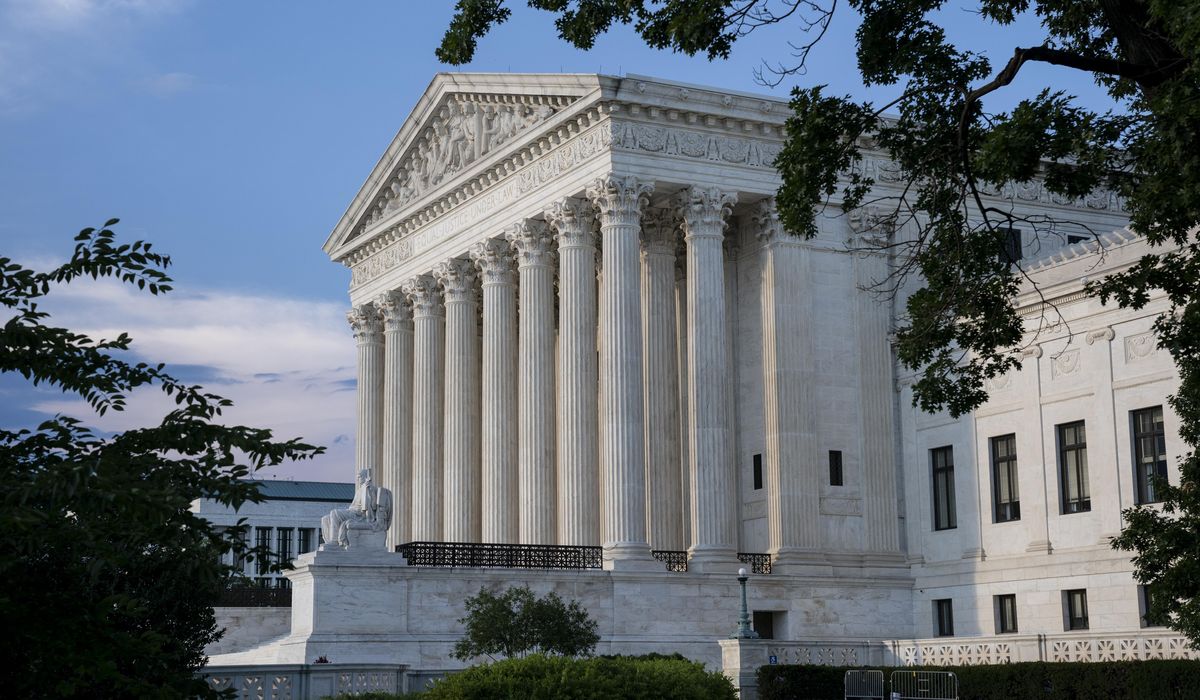
This week’s campaign and free speech cases aside, the Supreme Court closed out its first term with Justice Amy Coney Barrett and a 6-3 conservative majority by showing surprising agreement on everything from Obamacare to religious freedom to the 2020 elections.
David Cole, national legal director for the American Civil Liberties Union, said the term was “nowhere near as bad as people had thought” nine months ago, with the justices showing themselves to be less ideologically divided than the rest of the country on the big issues that came before them.
“I think with the very notable exception of the decision on the Voting Rights Act, the court largely confounded the predictions that it would decide cases on a 6 to 3 basis, that it would veer sharply to the right, that no liberal causes would ever have a chance of succeeding ever again,” he said.
The voting case was one of two hefty decisions that came down Thursday. It upheld Arizona’s election restrictions. The other struck down California’s attempt to get a look at secret tax documents identifying donors to nonprofit interest groups.
In each of those rulings, the six GOP-appointed justices were in the majority, and the three justices appointed by Democrats dissented.
After the death of Justice Ruth Bader Ginsburg and the confirmation of Justice Barrett, the third Trump nominee to make the high court, liberal activists had feared and conservatives had anticipated plenty of those sorts of rulings, as the GOP-named justices flexed their muscle.
But there were just 10 rulings issued with a 6-3 split along those ideological lines, according to SCOTUSBlog, which tracks the bench. Another eight cases were settled on 5-4 rulings with GOP appointees in the majority.
More common were cases like the 8-1 ruling earlier this month in favor of a foul-mouth high school cheerleader. The court, grappling with key First Amendment issues in the social media era, said school officials did not have a right to punish her off-campus speech blasting the cheer squad online.
Only Justice Clarence Thomas dissented from that decision.
Court watchers were surprised by a unanimous ruling in an LGBT rights case where the justices said Philadelphia violated Catholic Social Services’ First Amendment rights by trying to force it to place children with same-sex couples, violating the organization’s religious tenets.
Mr. Cole pointed to several criminal cases where he said the court “reached liberal results,” thanks to a split among the GOP appointees.
And in a 7-2 ruling, the justices — despite its conservative majority — dismissed a challenge to Obamacare, ruling conservative states didn’t have standing to bring their challenge.
That case had been a major flashpoint during Justice Barrett’s confirmation hearing last year, with Democrats predicting she would cement the doom of the 2010 Affordable Care Act.
Instead, she was part of the majority in a 7-2 ruling tossing the case.
Carrie Severino, chief counsel at the Judicial Crisis Network, said the Democrats were just trying to “scaremonger” over the case ahead of the 2020 election.
“I don’t think anyone who was really looking seriously at that case thought the ACA was going to be struck down,” she said.
Former President Donald Trump’s first pick to the high court, Justice Neil M. Gorsuch, dissented in the Obamacare case, but Justice Brett M. Kavanaugh, Mr. Trump’s second pick, joined Justice Barrett, Chief Justice John G. Roberts Jr., Justice Samuel A. Alito Jr. and the court‘s three Democratic appointees.
Mr. Trump let his frustration be known.
“I am very disappointed,” he told Real America’s Voice after the Obamacare ruling. “I fought very hard for them, but I was very disappointed with a number of their rulings.”
The court avoided some high-profile cases thanks to the change in administration, including a case on asylum policy and one on the legality of Mr. Trump’s diversion of money from Pentagon accounts to build the border wall.
President Biden reversed Trump-era policies and said they were no longer ripe for consideration. The justices agreed and deleted them from the docket.
Of the cases that were decided, Justice Kavanaugh emerged as the center of the court this term, according to SCOTUSBlog, which tracks the bench and said he was in the majority in 97% of cases.
“He is the median vote,” said Ilya Shapiro, director of the Cato Institute’s Robert A. Levy Center for Constitutional Studies.
Chief Justice Roberts and Justice Barrett were runners-up to Justice Kavanaugh for most times in the majority, analysts said.
“The fact that Barrett was in the majority as often as Roberts puts the lie to Democrats’ warnings that she would be a right-wing ideologue,” said Curt Levey, president of the Committee for Justice.
“Overall, the Court‘s decisions this term were moderate, with plenty of non-predictable configurations of justices,” he added.
There were plenty of disappointments for progressive activists even before Thursday’srulings.
Dan Goldberg, legal director for the Alliance for Justice, said the term was “sad” for the American people.
“The fact that a majority of the court did not adopt a ludicrous argument to take healthcare away from millions should not overshadow the fact that just today John Roberts and the other Republican-appointed justices continued their decadeslong push to eviscerate the Voting Rights Act, and making it easier for Republican state legislatures to entrench themselves in power by suppressing the vote,” he said.
Mr. Goldberg and experts from the American Civil Liberties Union warned about controversial cases on the court‘s docket for next term when the justices return from their summer recess in October.
Already on the court‘s agenda is a Mississippi ban on abortions after 15 weeks.
And the justices are set to test the limits of the Second Amendment with a case challenging New York’s requirement that people prove they have a reason to carry a concealed weapon in order to get a permit.
• Stephen Dinan contributed to this story.







